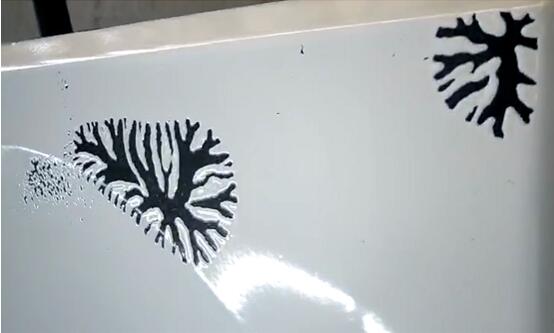How to Avoid Shrinking Enamel
"Shrinking enamel" is one of the common defects of enamel products, which can occur in both ground coat and cover coat. Shrinking enamel, also known as rolling enamel, escaping enamel, bald enamel, deglazing, etc.. The customary name this called in various places are different, but the problem all shown as shrinking of enamel after firing of the enamel product, which expose the metal oxide layer or ground coat layer. The separating of large area of enamel layer from metal body causes the lack of enamel in the area where is needed to be enameled, which will reduce the product grade or even scrapped, causing big loss to the manufacturer.

The production process of enamel products is long, resulting in many causes of defects. The problem is often long-lasting, and it is not easy to find out the cause and solve it in time. Therefore, the cause and prevention of shrinking enamel defects have always been valued by enamel workers. In this paper, Nolifrit experts briefly analyzed the causes and corresponding solutions for the defect.
The causes of shrinking enamel defects are roughly divided into the following aspects:
1.Wet defects.
Insufficient degreasing of the body or oil stain on the surface of the ground coat may cause shrinkage defects. It is easy to understand that the body and porcelain surface contaminated by oil stains have a repulsive force on the enamel slurry, which makes the enamel slurry not easy to adhere and it is difficult to form a complete porcelain surface.
2.The enamel slurry is too fine.
The fineness of the grinding is too fine, and the enamel slurry has poor retention properties when the enamel slurry is applied to the body, and the enamel slurry cannot stay on the iron blank. When the fineness of the enamel is too fine, the voidage between the particles is lowered, and internal moisture and other various gases are less likely to penetrate the powder layer to cause accumulation and increase pressure, thereby causing “"Shrinking enamel"” phenomenon.
3.The fineness is too fine, resulting in a decrease in the strength of the enamel slurry layer. For general daily use products, the fineness of enamel slurry should be controlled within 1.0~1.5g / 100ml.150 mesh, and the clay content should be controlled within 6.0~7.0%, which can effectively overcome the shrinkage enamel phenomenon.
4.Insufficient drying or sudden drying into an area where the temperature is too high, the drying temperature is too high too fast
5.Poor quality or insufficient amount of clay in enamel.
If the amount of enamel slurry clay is low, the enamel slurry has a large fluidity, but the enamel slurry has poor suspension performance and a low yield value. Appropriate increase in the amount of clay can increase the yield value of the enamel. The flow properties of the enamel slurry can be controlled by adjusting the bulk density of the enamel. The increase in the amount of clay can also increase the strength of the powder layer and expand the firing rate of the enamel. In particular, it should be noted that most of the enamel is produced when each enamel is about to be used up. According to the analysis, the main cause of the problem is that the agitation of the enamel pool is insufficient to cause uneven enamel composition. The clay has a small specific gravity suspended in the upper part of the enamel slurry, and the enamel particles have a large specific gravity and are easily precipitated. The enamel slurry is not fully stirred, and the upper layer has a small specific gravity. The lower part of the precipitate is taken more, so that the clay content in the remaining enamel slurry is low, and the adsorption capacity of the green body during glazing is poor, and the enamel will be severe.
6.The dry powder layer has poor strength and cracks due to vibration. It can be solved by grinding sodium aluminate.
7. The enamel is too thick or the enamel slurry is too dense. The weight of the enamel can be adjusted to improve the operation level of the worker.